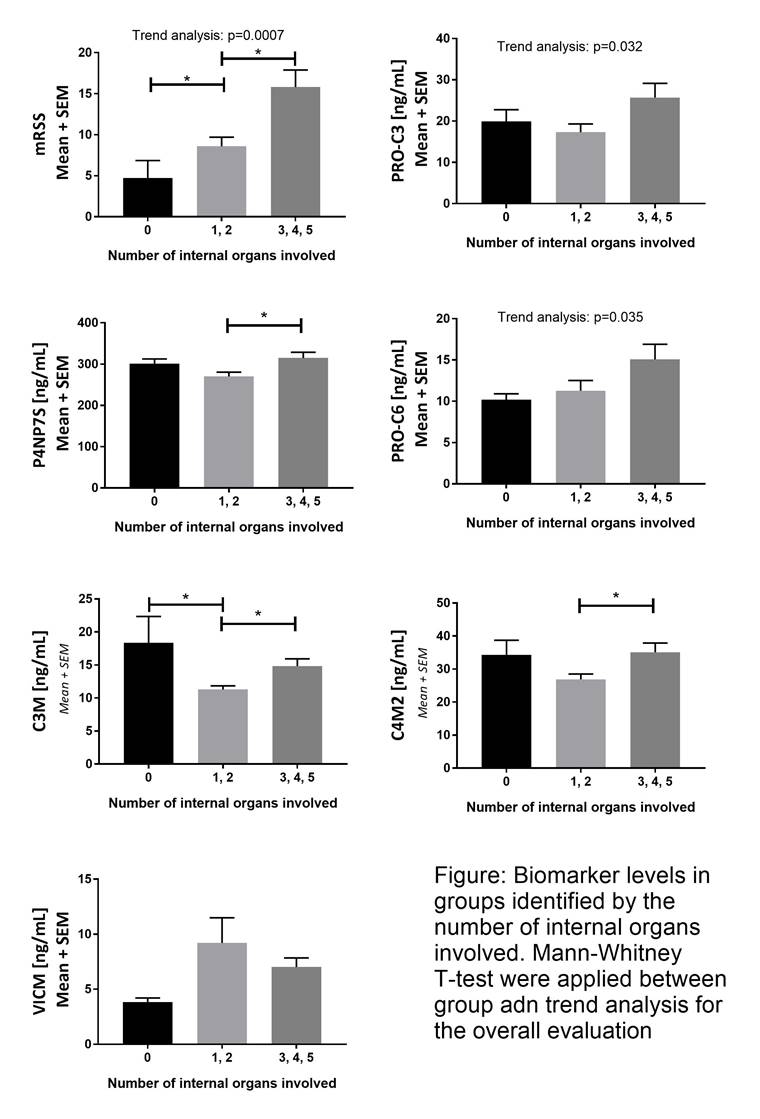Session Information
Date: Tuesday, November 7, 2017
Title: Systemic Sclerosis, Fibrosing Syndromes and Raynaud's – Clinical Aspects and Therapeutics Poster III
Session Type: ACR Poster Session C
Session Time: 9:00AM-11:00AM
Biomarkers that can monitor the fibrotic burden will aid in trial enrichment and personalized health care in SSc. SSc is associated with internal organ involvement (lung, renal, and gastrointestinal) in the form of fibrosis. Fibrosis is unbalance in extracellular matrix (ECM) turnover and protease specific protein fragments are released during fibrosis. The main family of protein in ECM is collagen, with type I, III and VI localized to interstitial matrix and type IV collagen localized to basement membrane. The aim of our study was investigating biomarker levels relation to the amount of internal organ involvement. Methods:
Serum from 79 SSc and 19 asymptomatic individuals were included in the study. Biomarkers of type I, III, IV, V and VI collagen formation (P1NP, PRO-C3, P4NP7S, PRO-C5, PRO-C6) and degradation (C3M, C4M2, C5M, C6M) and citrullinated and MMP-degraded vimentin (VICM) were detected by ELISA. Modified Rodnan skin score (mRSS) and extent of internal organ involvement (renal, lung, vasculopathy, and upper and lower gastrointestinal) were recorded for SSc patients with a scoring between 0 and 4 with 0 being no involvement and 4 being severe involvement. Patients were categorized as having no internal organ involvement when 0 and minor with 1. A score of 2, 3 or 4 were classified as definite. Statistics was Mann-Whitney t-test, Spearman’s and trend analysis. Results:
SSc patients had a mean age of 63.0 years, mean disease duration of 98.3 months and a mean mRSS of 11.1. Patients compared to controls had higher levels of C5M, C6M and PRO-C6 (p=0.0001, p<0.0001, p<0.0001, respectively). Type VI collagen formation and degradation (PRO-C6 and C6M) were twice that of healthy controls (12.6 vs. 5.4 and 26.0 vs 16.7 ng/ml, respectively). C4M2, PRO-C3 and PRO-C6 was associated with skin fibrosis assessed by mRSS (Spearman’s rho=0.24, 0.39 and 0.29, respectively). mRSS was significantly increased with the amount in internal organ involvement (p<0.005). C3M, C4M2 and P4NP7S levels were lowest in the group of patients with some internal organ involvement (p<0.05) and PRO-C6 trended to increase with the number of organs involved (p=0.035). Conclusion:
Biomarkers of collagen turnover, a surrogate of fibrosis, were increased in SSc and were related to the number of internal organs involved. This study illustrates that biomarker levels of ECM turnover needs to be carefully evaluated in SSc patients in regards to the amount of internal fibrosis.
To cite this abstract in AMA style:
Siebuhr AS, Kubo S, Juhl P, Nakano K, Nakayamada S, Karsdal M, Bay-Jensen AC, Tanaka Y. Collagen Metabolite Biomarker Levels Are Associated with the Amount of Fibrosis in Internal Organs in Systemic Sclerosis Patients [abstract]. Arthritis Rheumatol. 2017; 69 (suppl 10). https://acrabstracts.org/abstract/collagen-metabolite-biomarker-levels-are-associated-with-the-amount-of-fibrosis-in-internal-organs-in-systemic-sclerosis-patients/. Accessed .« Back to 2017 ACR/ARHP Annual Meeting
ACR Meeting Abstracts - https://acrabstracts.org/abstract/collagen-metabolite-biomarker-levels-are-associated-with-the-amount-of-fibrosis-in-internal-organs-in-systemic-sclerosis-patients/

